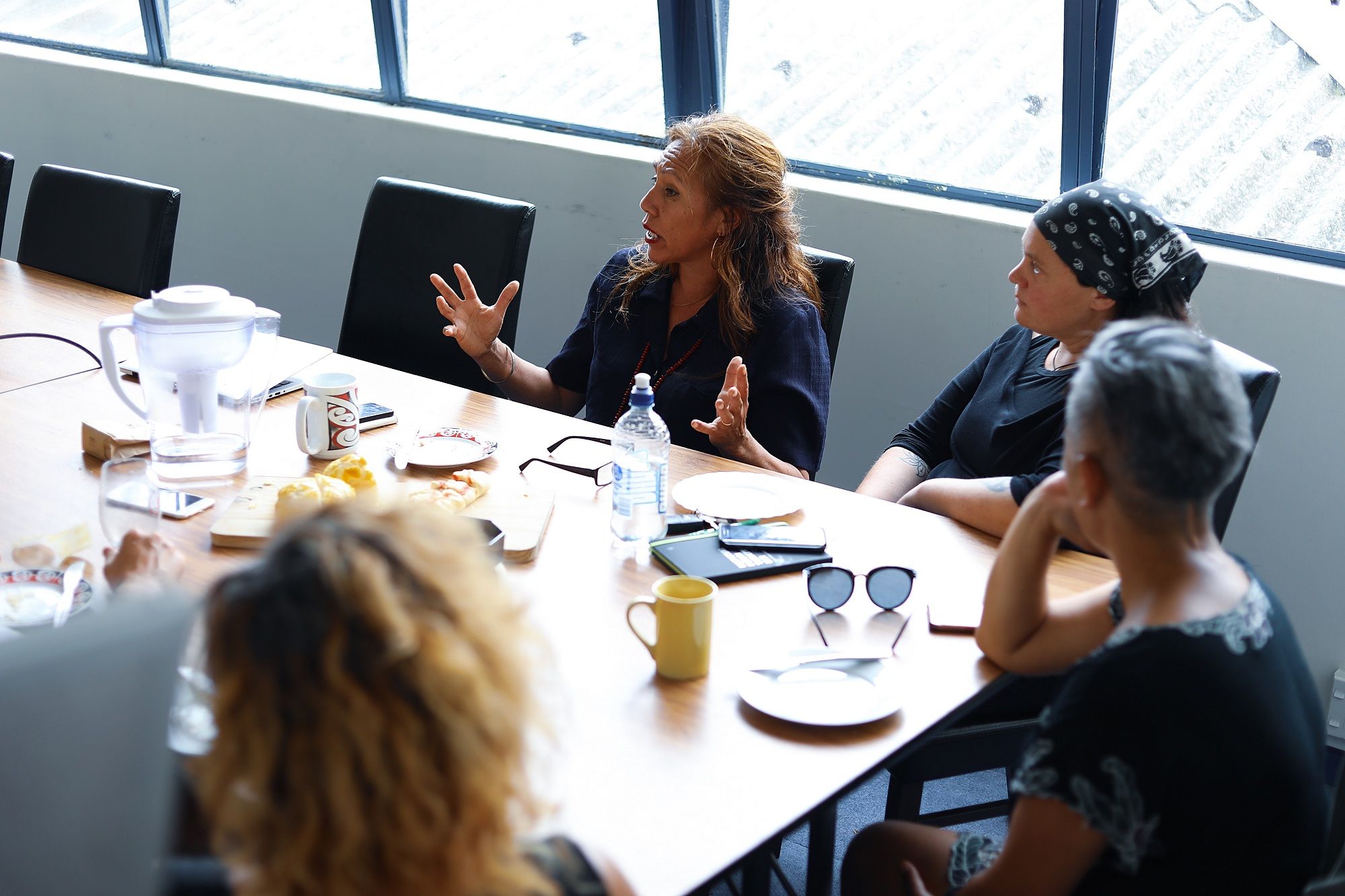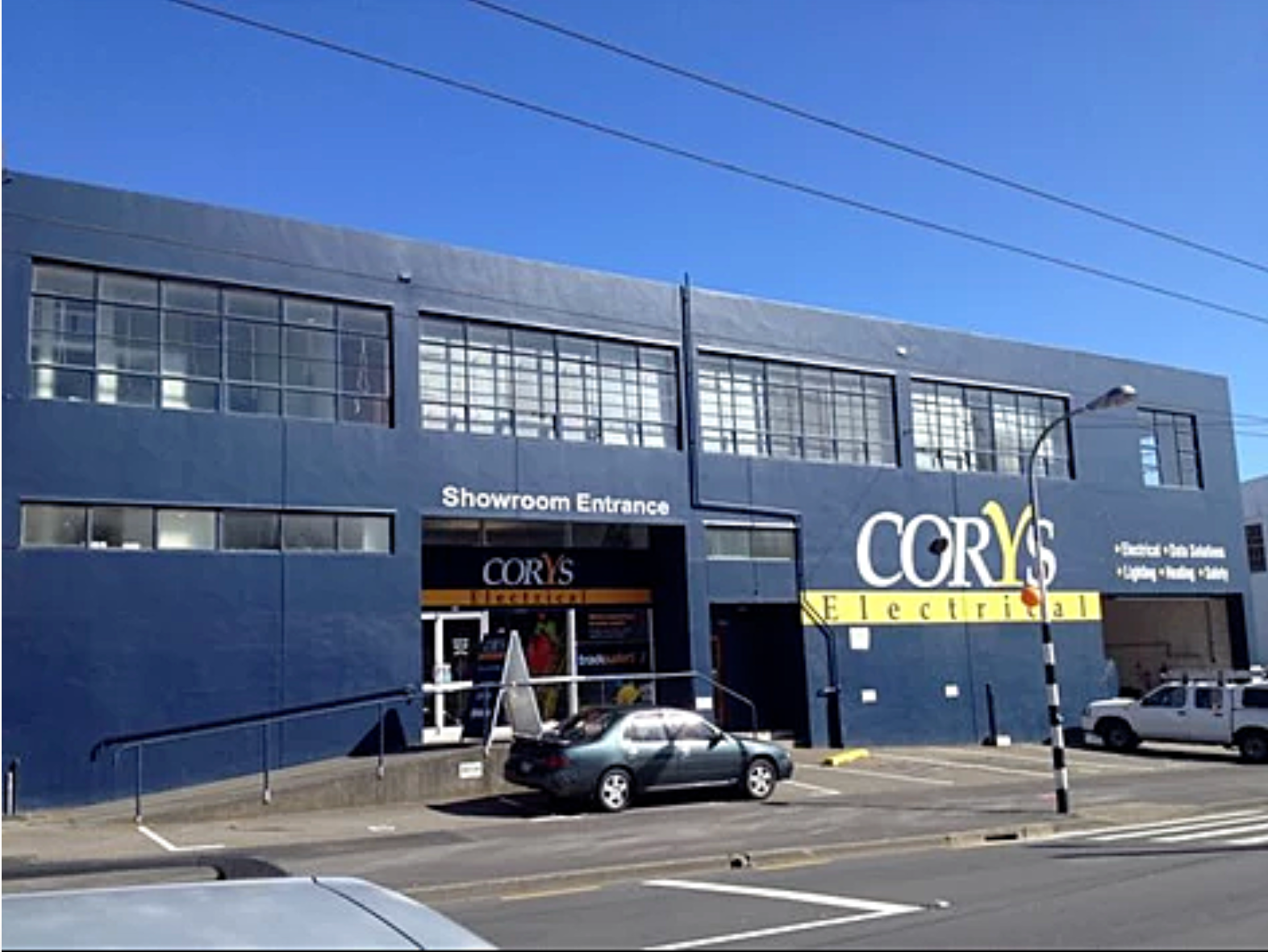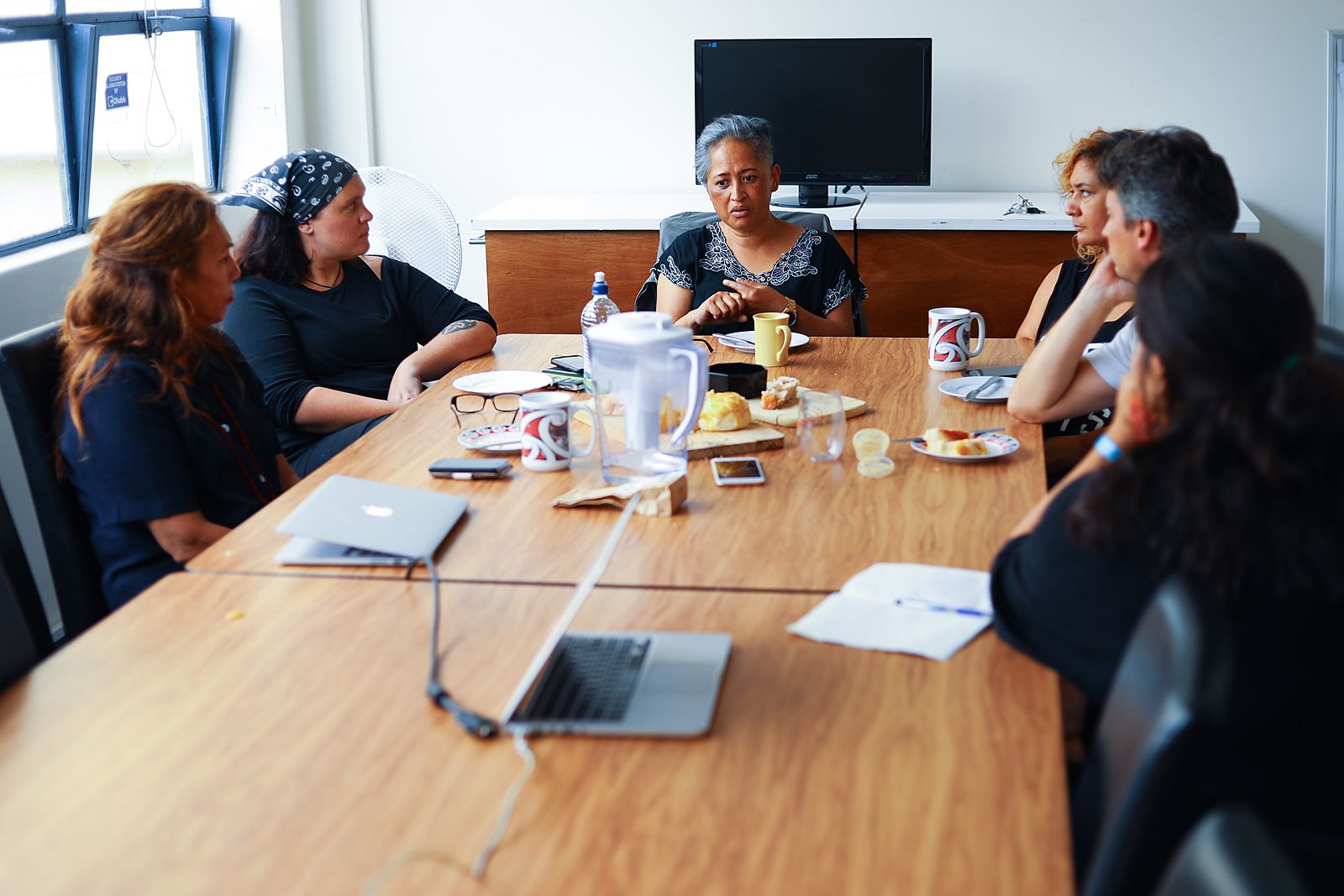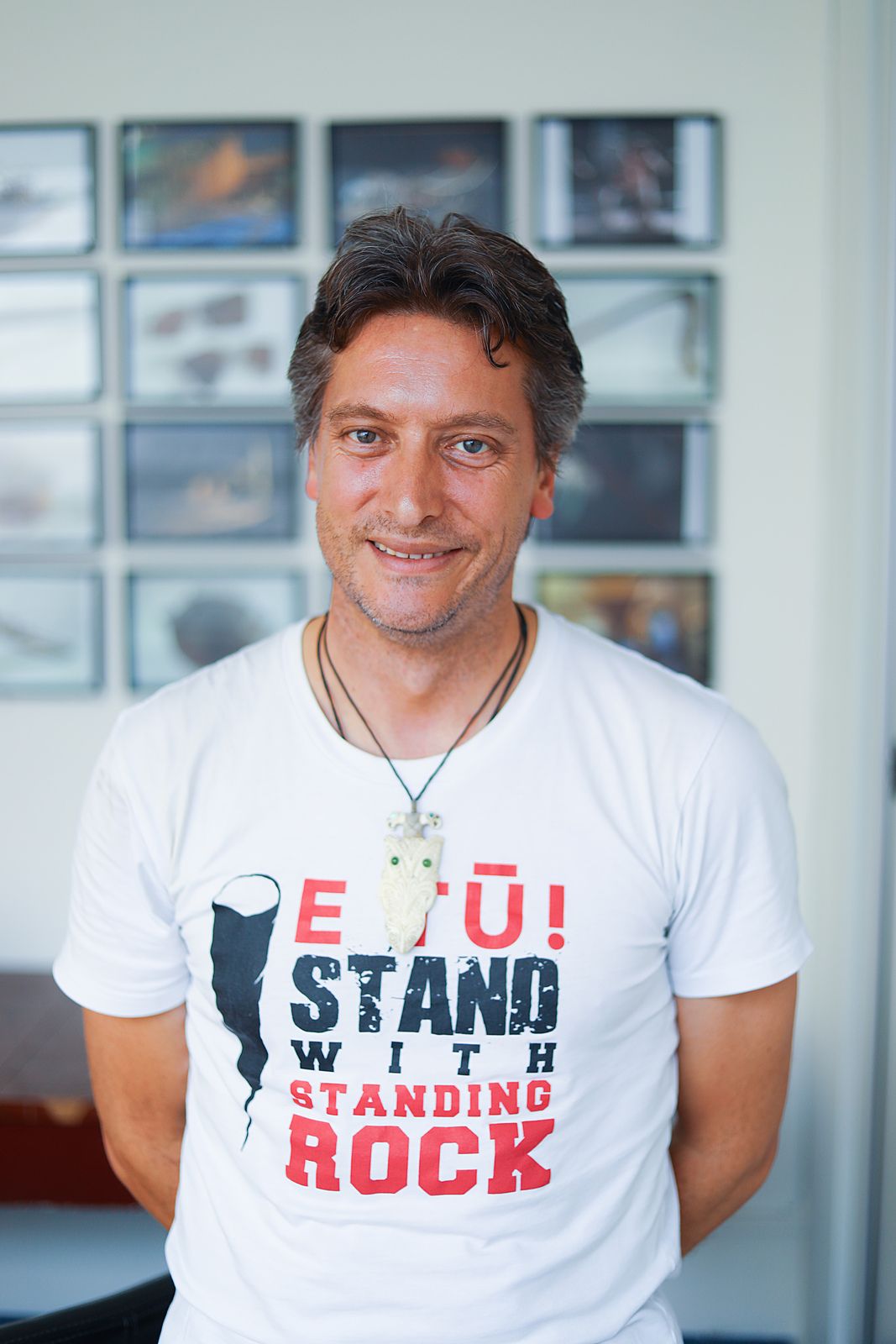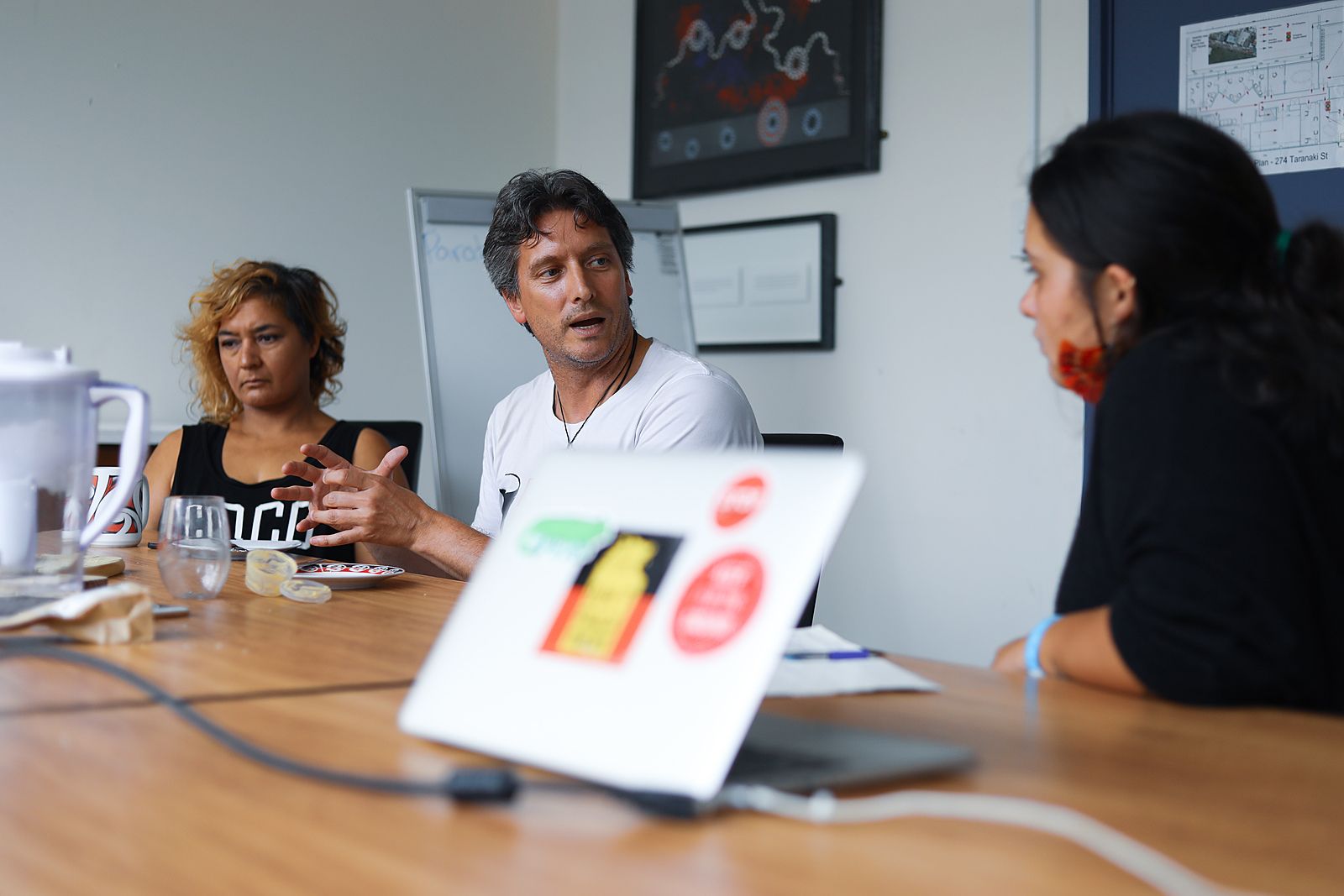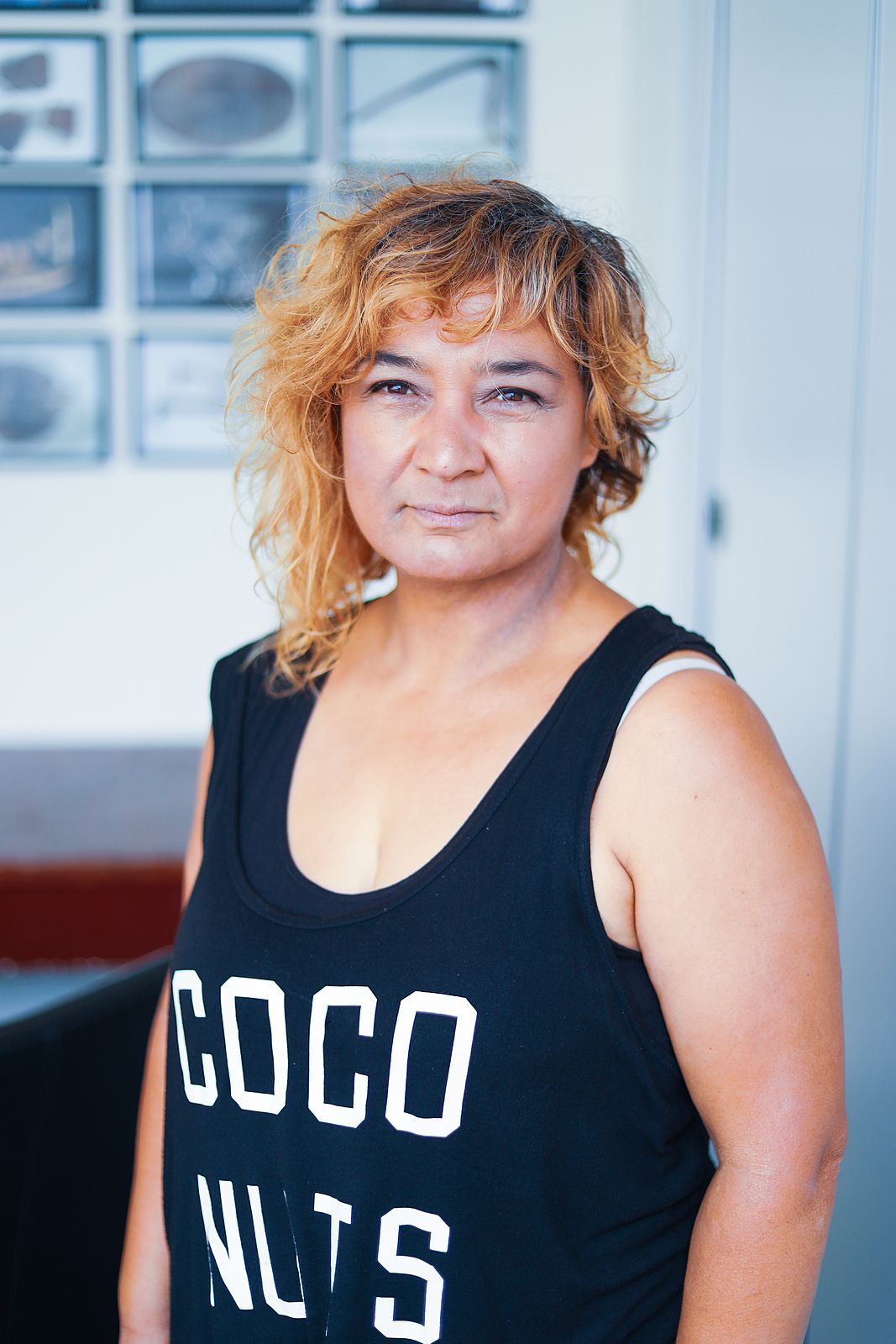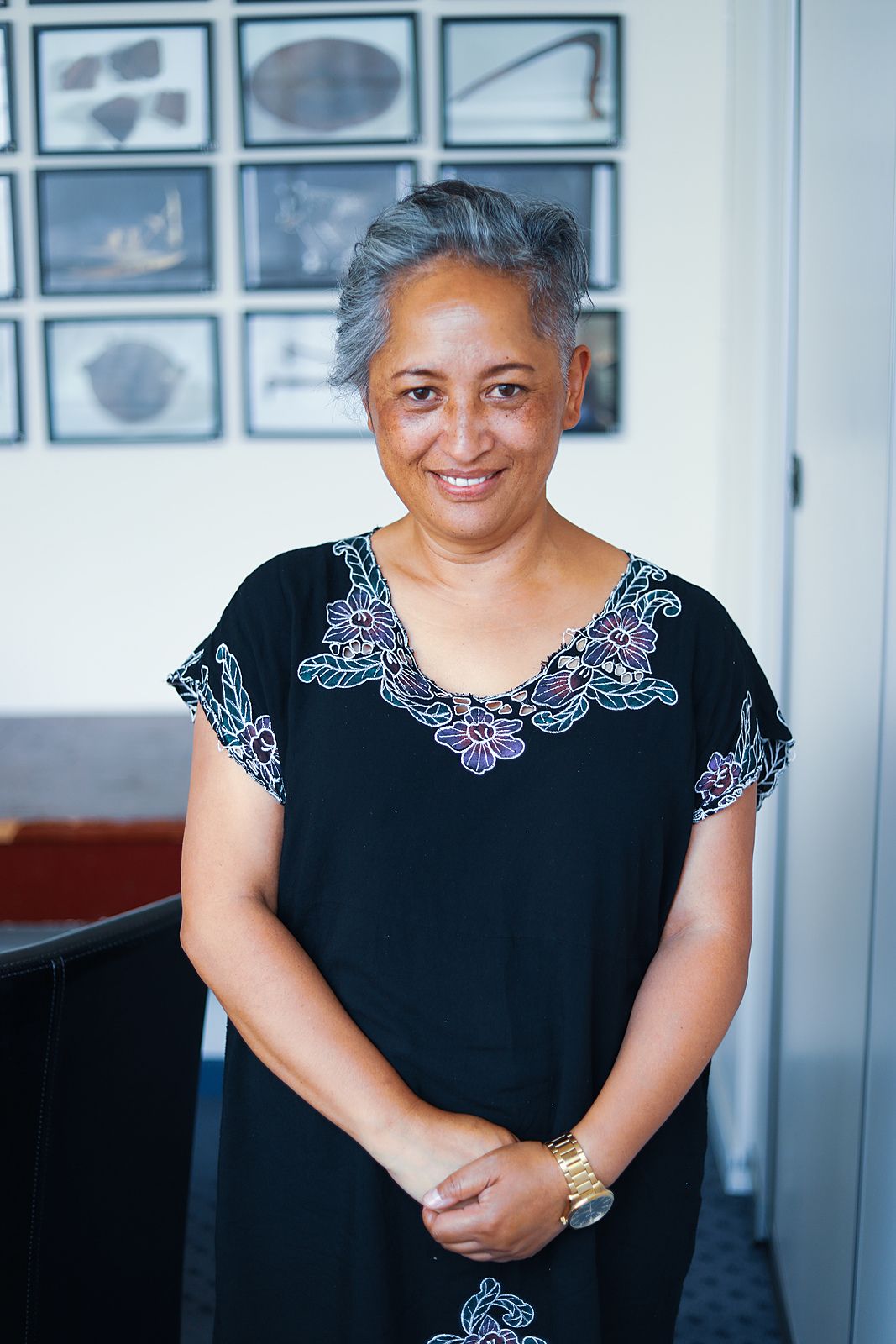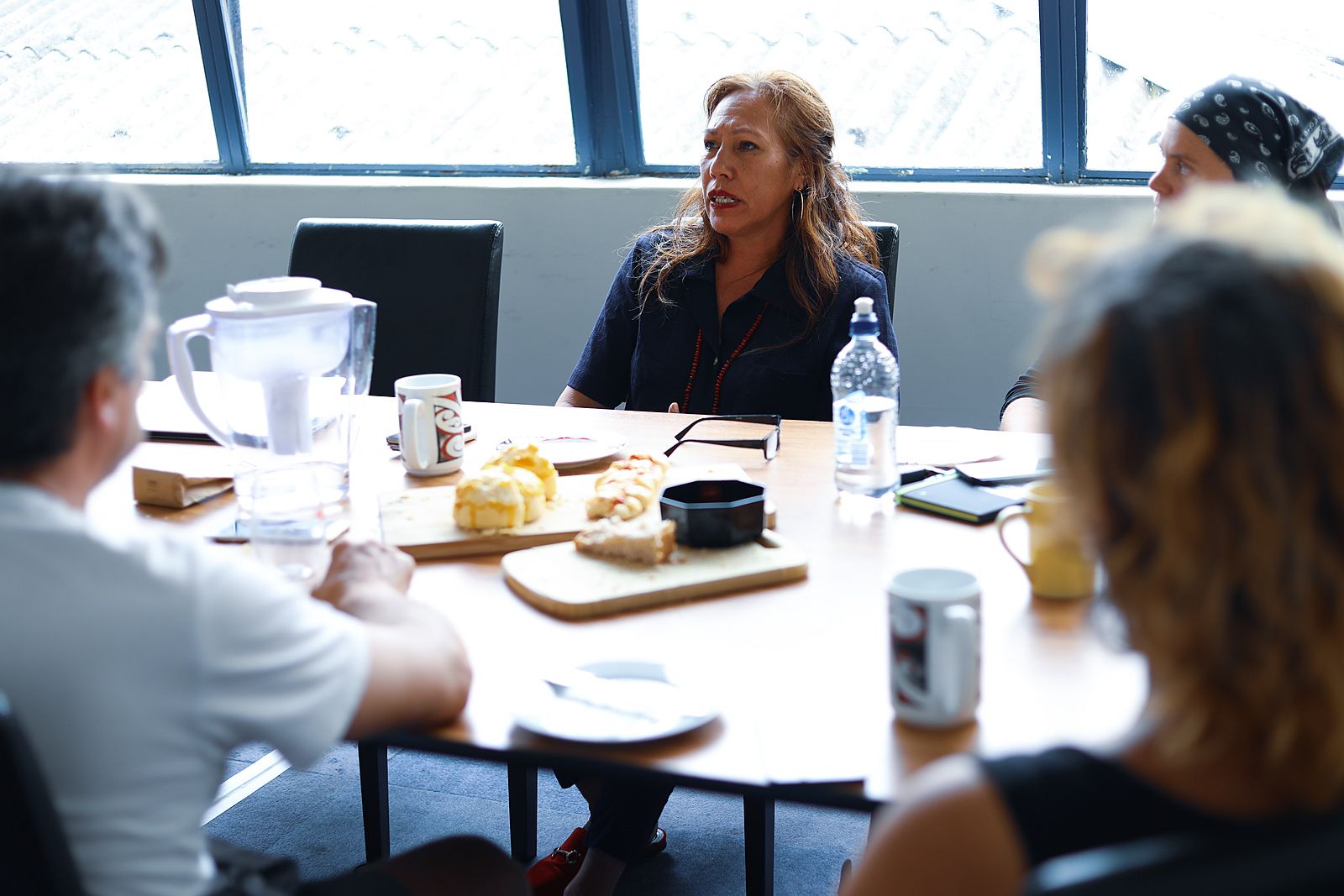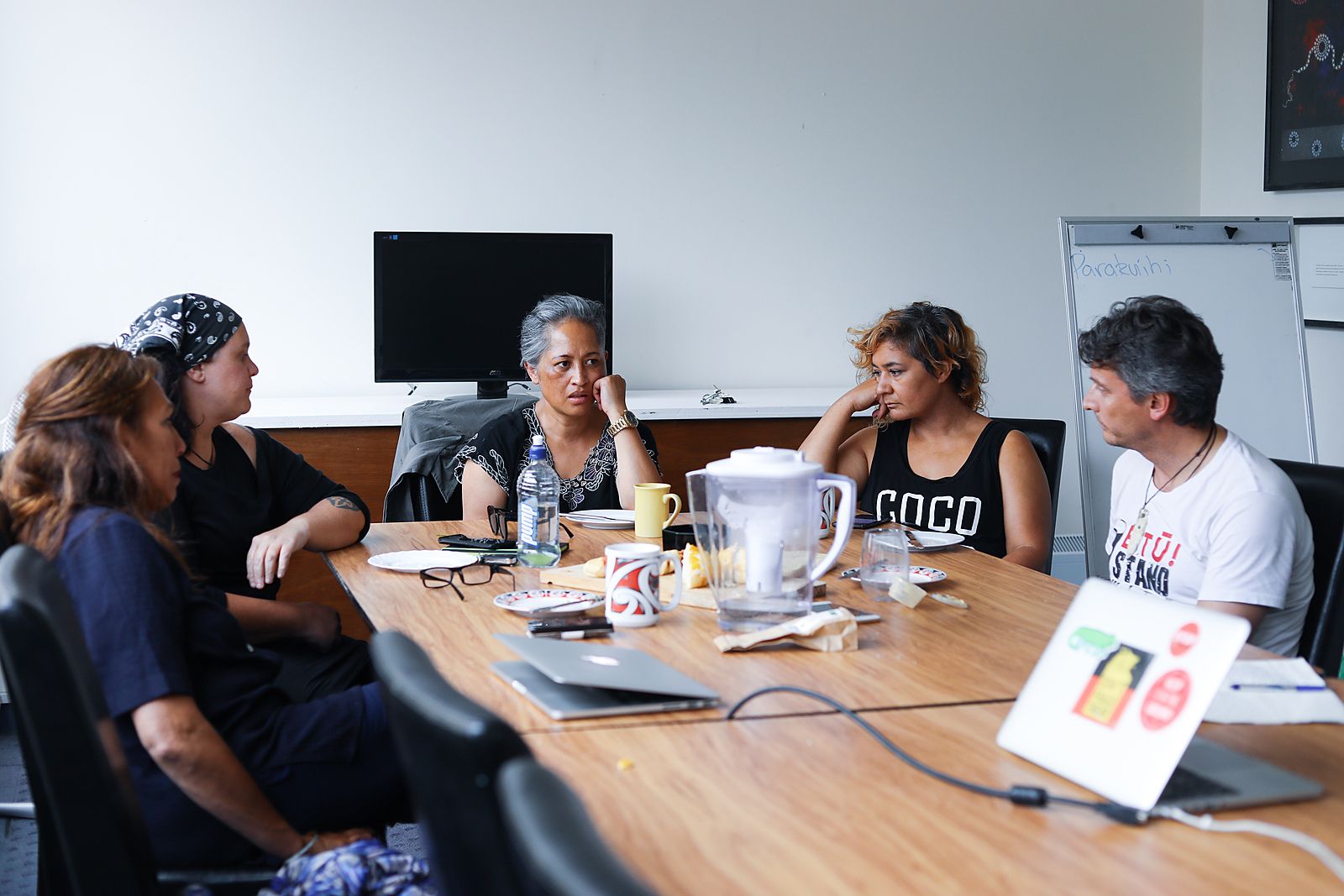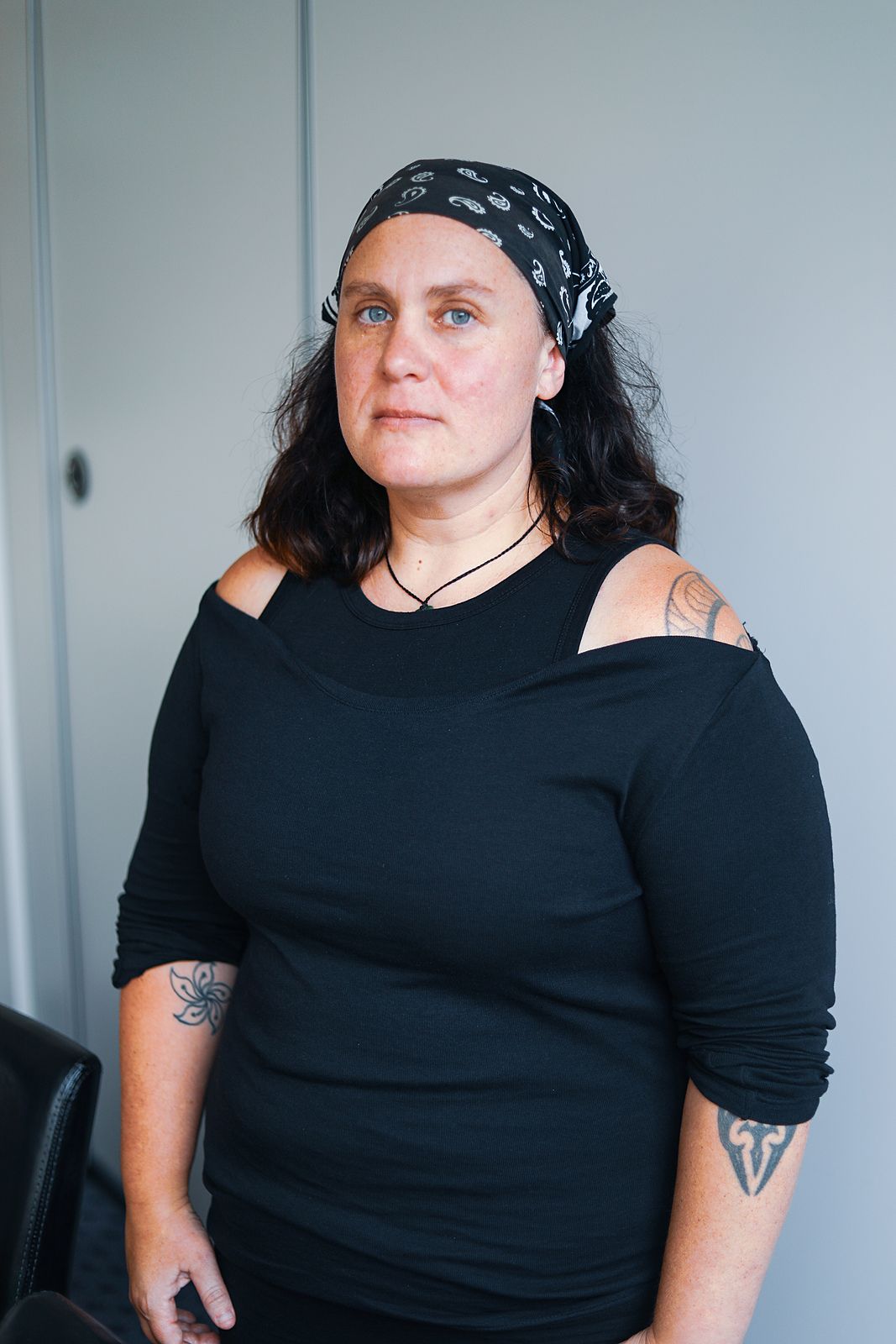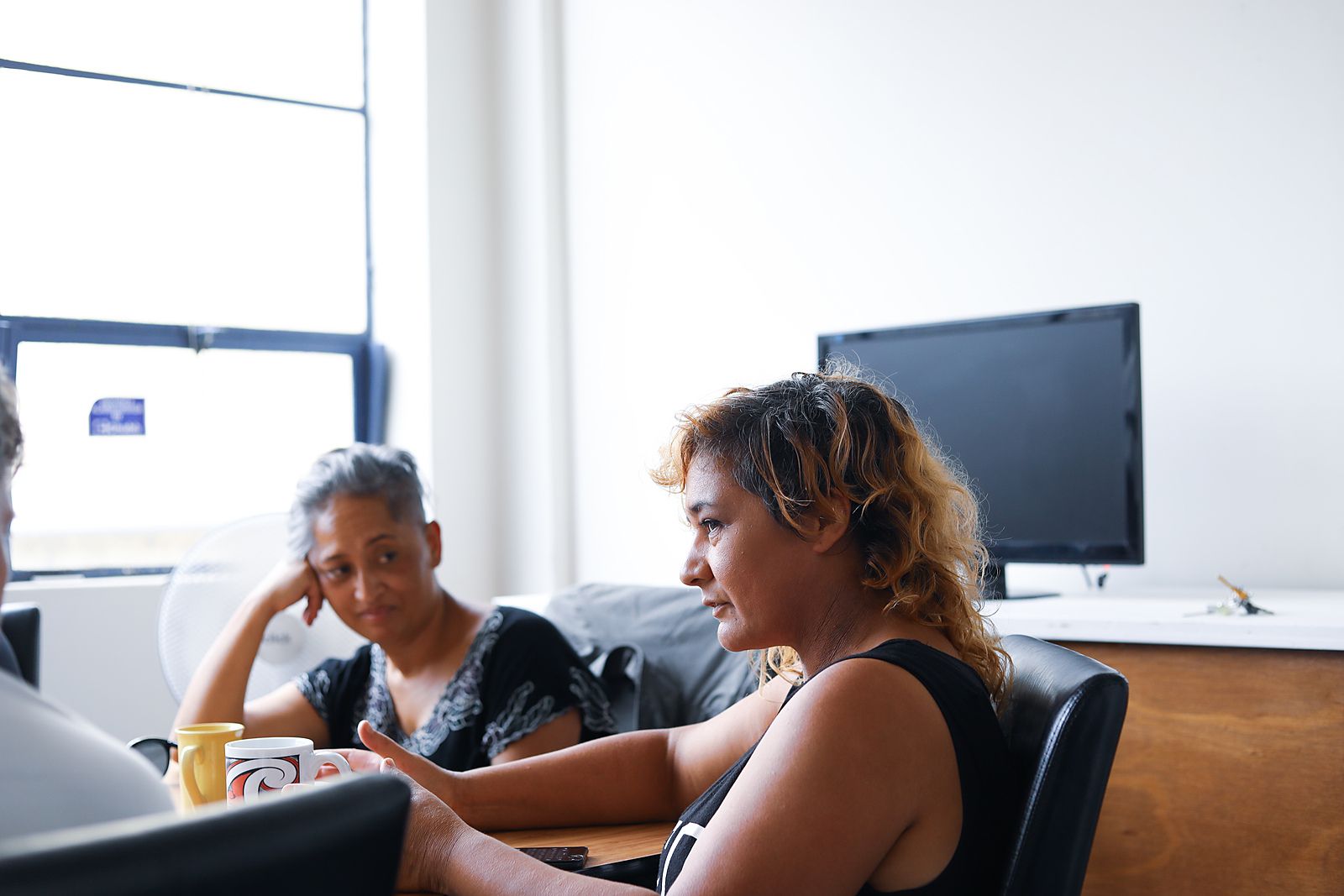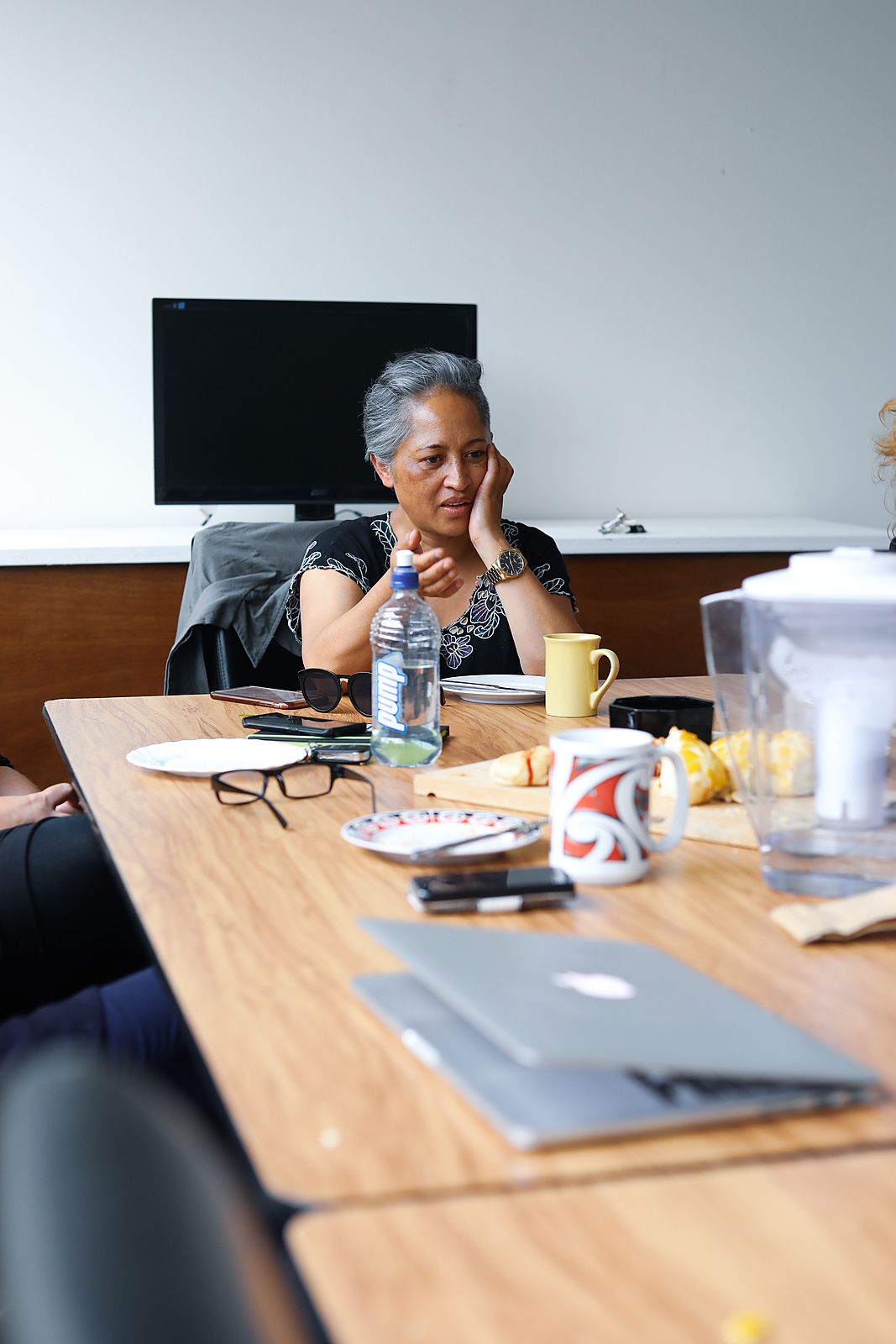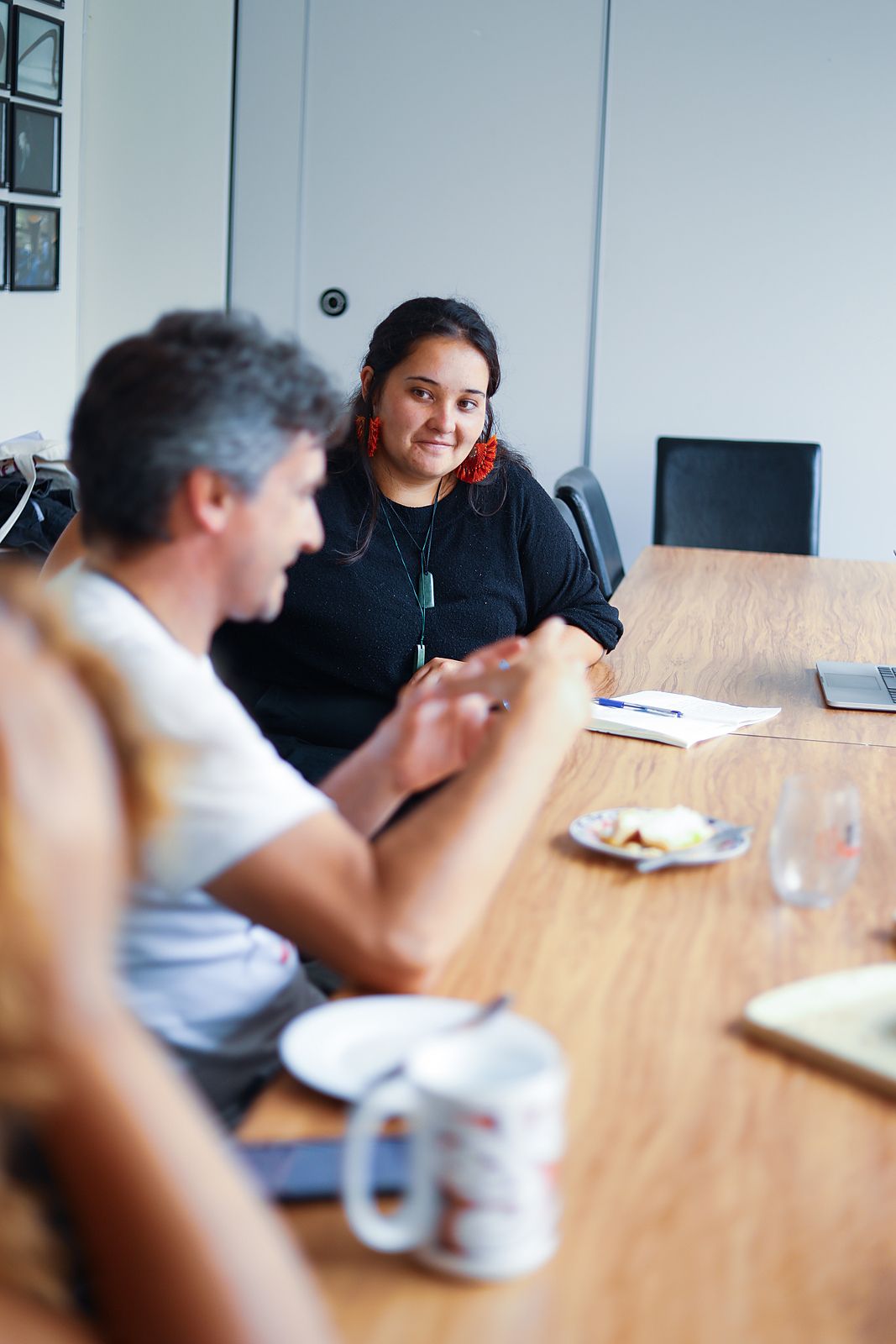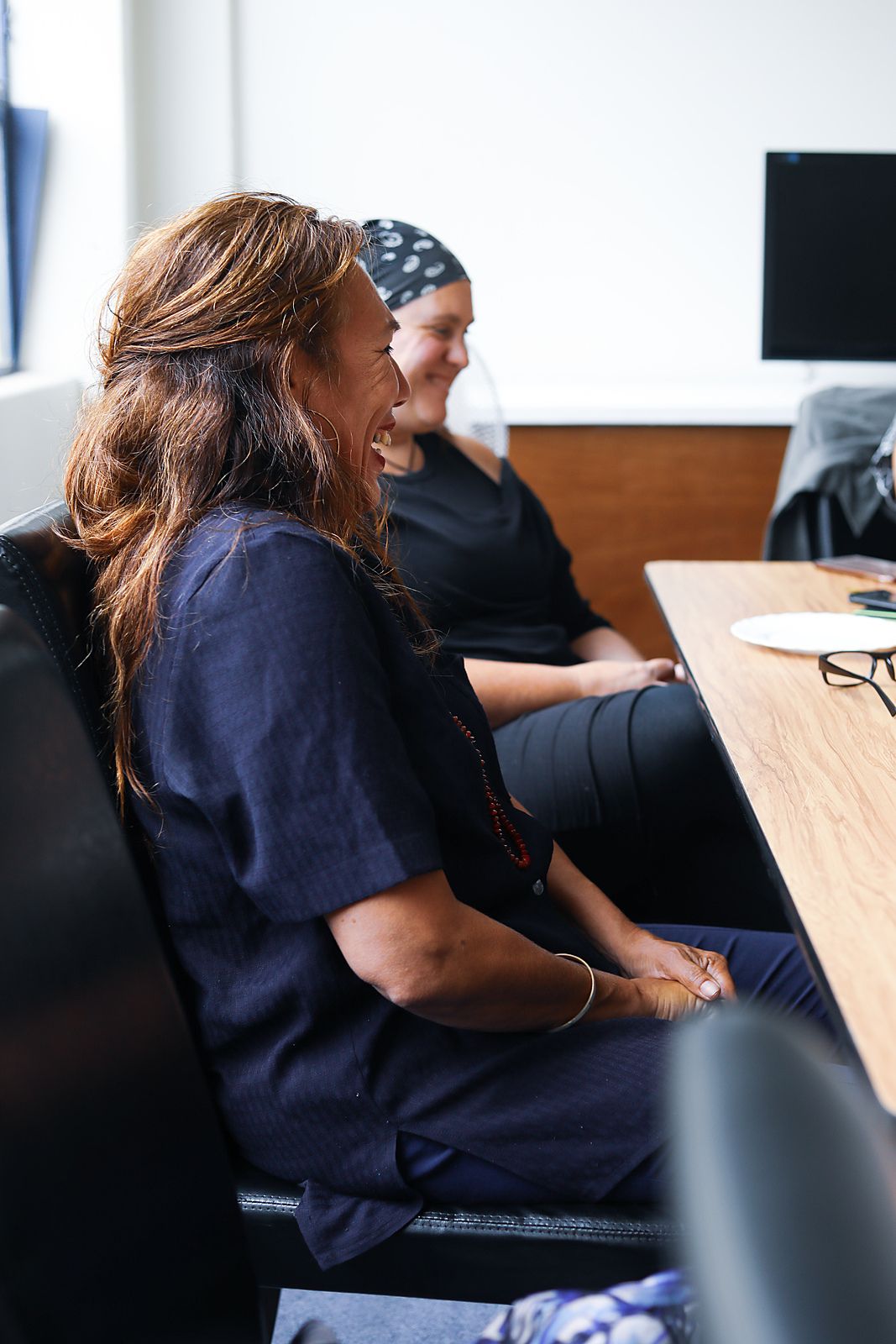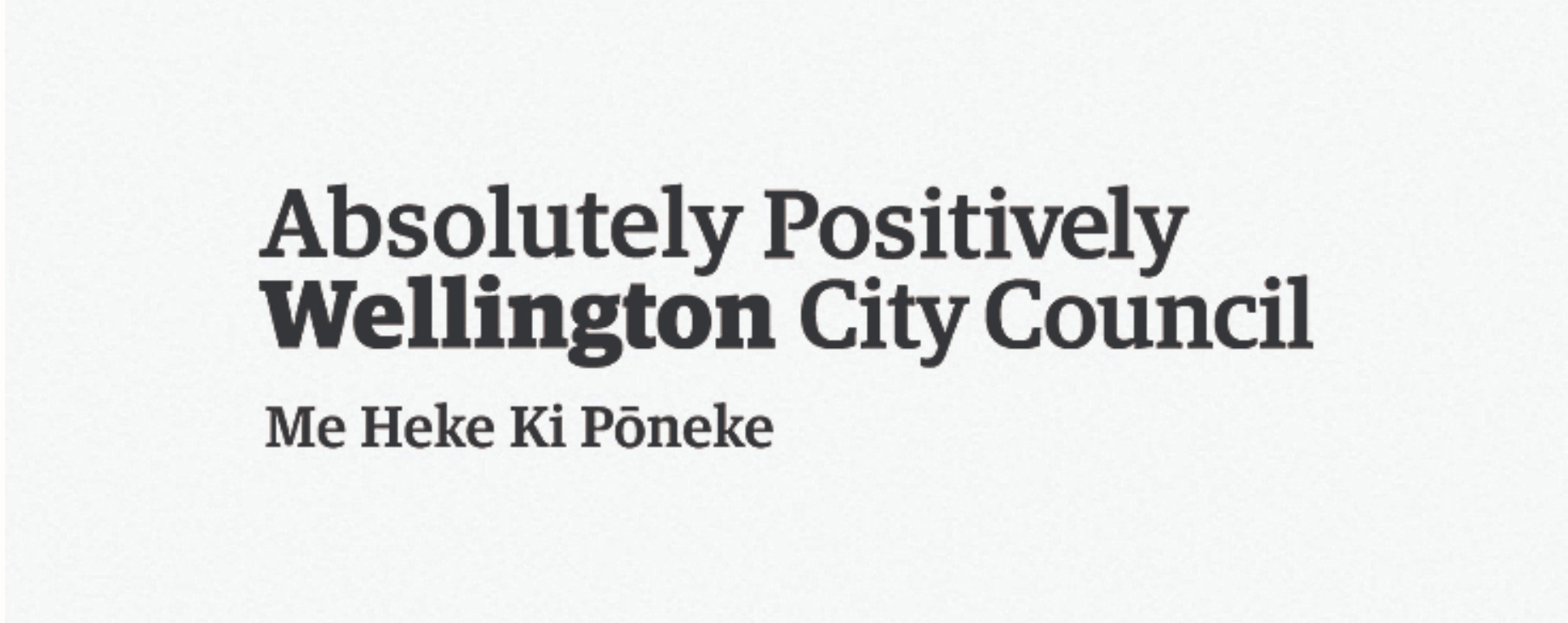Build Your Own Whare: The Voices of Te Haukāinga
The artists of Te Haukāinga on holding the history and building the future of Māori and Pacific Theatre in Pōneke
Nearly three years ago, three major New Zealand theatre companies - Taki Rua Productions, Tawata Productions and The Conch - came together to build a home for Māori and Pacific theatremakers in Pōneke, and its impact on theatre in the city and in New Zealand has been incalculable. Kahu Kutia sits down with some of movers and shakers behind the performance hub to talk about the pain of the past, the joy of the present and a future where Māori and Pacific makers aren't manuhiri in someone else's space.
If you live in Wellington, you’ve probably gone past it a million times. From the outside it’s invisible, but on the top level of 274 Taranaki Street is a whare that holds a powerful legacy of Māori and Pacific theatre in Wellington, which serves as a hub for a community of Indigenous creatives and their whānau: Te Haukāinga.
Te Haukāinga continues the legacy of The Depot, Taki Rua’s original theatre space on Alpha Street, just off Courtenay Place. In the 1980s and 1990s, The Taki Rua Depot was home to Wellington’s Māori and Pacific theatre scene, as well as the city’s dance, and Gay and Lesbian theatre, communities. Even Fat Freddy’s Drop had some of their first rehearsals there. The Taki Rua Depot closed in 1997 and Taki Rua became an independent production company, leaving the Māori and Pacific theatre communities without a place to hold their mahi that was their own.
Three of the city’s most prominent Māori and Pacific companies, Taki Rua, The Conch and Tawata Productions, resolved to change this and in 2016 opened Te Haukāinga, the second home for this legacy in the creative arts. Te Haukāinga is home for these companies and for others, including Hāpai Productions and Tikapa Productions, who work in Te Hau Tūtū independent producers office.
Hundreds of creatives from across the Pacific and the world will land at Te Haukāinga every year. Many are drawn by the Kia Mau Festival, held annually in May/June. Kia Mau grew from a need to celebrate all the Indigenous theatre being produced in Wellington and beyond, to hold a central platform amidst the wider Wellington arts scene and say, “Hey, these are the voices you need to be listening to.” That was the goal of festival directors Mīria George and Hone Kouka. Last year they programmed the Whangarei Girls High production of Waiora – one of Kouka’s own works. Not only did the show receive incredibly positive reviews, but those rangatahi spent a week in workshops as part of Kia Mau Festival, learning from the pakeke in Te Haukāinga a broad range of theatre, dance and production skills. Similarly, Nina Nawalowalo and Tom McCrory built Conchus Youth as a way to engage with young Pacific practitioners of theatre. Conchus Youth has moved out of Te Haukāinga into their own independent space.
It is precisely because Te Haukāinga is a dynamic and culturally strong space that so many strong works have been produced in the last few years. The Conch’s The White Guitar, Hāpai’s Portrait of a Artist Mongrel, Taki Rua’s He Kura E Huna Ana, Tawata Productions’ The Vultures. Taki Rua has just commenced a season of the Patricia Grace story Te Kuia Me Te Pūngāwerewere. This is theatre that centres Te Ao Māori and Te Moana Nui a Kiwa in its worldviews. Weaving in characters who are recognisably voices of the Pacific. Separate from the token brown character often utilised in mainstream theatre, spaces like Te Haukāinga encourage storytelling that is as diverse as our people. With many narratives left to be told.
With kai and cups of tea, Kahu Kutia talked to some of the voices who occupy Te Haukāinga. Those voices were: Tanemāhuta Gray, Chief Executive of Taki Rua Productions; Nina Nawalowalo, Artistic Director and co-founder of The Conch; Nancy Brunning, Company Director of Hāpai Productions; Helena-Jane Kilkelly, co-founder of Prospect Park Productions and producer for the Kia Mau Festival; and Erina Daniels, independent performer, producer and director of productions like Party with the Aunties and Shot Bro: Confessions of a Depressed Bullet.
Kahu Kutia: First off I want to go back to the inception of the space. Te Haukāinga. Why was this space needed for you guys? Why did you need to work together?
Tanemāhuta Gray: I’m going back to my time at Taki Rua on Alpha Street, when it was a theatre space. Back then we still felt on the fringe of the community, but what we had was such a broad community. It was Māori and Pacific, the Gay and Lesbian community. There was a broad range of theatre forms coming through. A lot of artists’ first works were coming in there.
When that space closed down, it was like the community had no place to gather. Myself and The Conch were sharing a room in 170 Cuba St, and trying to fit in that 40-square-metre room with both of us was just hell. I realised that if we could pile our forces together we could get a much bigger space, with all the separate little entities we’ve got like Taki Rua, like The Conch. That’s kinda how that desire came through. Tawata were a big part: they said, “Yep, if you can get it we’ll be jumping in on that as well.” Those three partners together were vital: Taki Rua, The Conch, Tawata Productions.
Nancy Brunning: We had Te Pūtahitanga a te Rēhia, which had regular meetings. This was at the time when Māori were being ignored on the mainstages, there was a real disconnect with some of the practitioners and industry people, so we decided to come together and form Te Pūtahitanga in 2013, and just talk and support each other.
[Te Pūtahitanga a te Rēhia was formed out of a disconnected Māori theatre scene to rebuild trust and communication between individual Māori practitioners and Māori companies. They advocate, tautoko, and create platforms and opportunities for Māori artists. Hāpai Productions, Tawata Productions, Te Rakau Hua o te Waotapu, Tikapa Productions, as well as many individuals in the industry, founded Te Pūtahitanga in 2013.]
[But] the message is very important that Māori and Pacific, we are all one, so for us it was just a natural thing to come together.
A space where we could all come together was really important because it meant we could all share our resources. We found out there were a lot of emerging artists who did not know what to do once they graduated drama school, and there wasn’t a physical place that could welcome them in. We’d have meetings just in each other’s houses or whatever and we’d talk about what we needed. Yeah, we were homeless for a long long time! Fifteen years.
The majority of work [getting made at that time] was made by people who probably weren’t getting funded, but they were upskilling. They were producing new works, and they were actually creating a name for themselves without the help of any mainstream organisations out there.
Nina Nawalowalo: For The Conch it is political. Because when the offer and the conversation came about to come together collectively and you have to look for money – the natural thing is to work against each other. Everyone’s trying to survive. [But] the message is very important that Māori and Pacific, we are all one, so for us it was just a natural thing to come together.
But it also provides safety for us as a company because it’s a collective where we’ve got key companies being funded. That allows the holding of everybody else. It created a lot of interest all around the country when all of us came together.
KK: Being homeless for so many years and then coming together: were there any leaders in that? Or was it just general wide consensus that this was needed?
TG: It was a general, wide consensus that we needed something because what was happening wasn’t working and we were being siloed off. I thought that if we could build a beacon of community, it just needed the response and the connectivity of our energies together. We knew we could make a force that was quite unstoppable!
In a way I think Wellington actually needed this. In its other theatres, Wellington was lacking the leadership to guide Māori and Pasifika as well. We weren’t being served in those whare at all. If you end up being the chosen one for one particular theatre company, yes, you’ll get those opportunities but you’ll never build that sense of your tino rangatiratanga. You’re always running things the way they dictate it! We had enough experienced practitioners to say not only can we run it, but we can also be quite revolutionary. We get to dictate it rather than being manuhiri in another person’s whare.
NB: That’s hard yeah, being a manuhiri in someone’s space all the time…You don’t develop at all and you’re constantly giving your intellectual property to somebody else. Meanwhile they’re growing and they’re getting more funding because they’ve got you in their building. But they don’t do any of the thinking, the planning, the strategy and they don’t do the production. That’s all you.
We had enough experienced practitioners to say not only can we run it, but we can also be quite revolutionary. We get to dictate it rather than being manuhiri in another person’s whare.
Me and Erina and HJ, we’re part of Te Hau Tūtū. As independents working in that little office space, we’ve had to figure out how to contribute more to Te Haukāinga. It’s like any pā or marae really, where everyone has a role to play and we all have to contribute in some kind of way.
It’s also a space where we can nurture our babies at the same time. But our challenge is bringing our kaumātua up here more so that their korero can be shared with some of the young ones that come through.
TG: Look at what's happened the last three years, works from this building have inhabited so many festivals. Kia Mau Festival, the Indigenous theatre festival, is now something that all the other festivals are coming to raid. Each year it keeps establishing itself; its purpose or focus will change every year. I think what Mīria and Hone have established is really on the pulse of what we need.
NB: At the moment we have the freedom for the art to dictate who the audience is, rather than the audience dictating what the art is. We’re at that stage and hopefully it won’t change too soon, because it means artists can be artists.
Added to that mix is the stuff that Indigenous manuhiri from overseas, which New Zealand doesn’t show at all. It’s really amazing to be able to attract people like that into a space like Te Haukāinga where you can pōhiri them in and give them a feed, or if they need somewhere to use a computer they can do that here. It’s creating a space where people can become more accessible to one another.
NN: What has come out since we have been in this space is not by chance. It has to do with the collective energy of Te Haukāinga. It’s a tough business and it’s tough to have an idea. There’s too much elbowing in this business, and what we’re saying is that we don’t buy in to that.
[Collective agreement from everyone in the room.]
Haukāinga is a platform for meeting, creating, discussing, sharing, then growing. But that’s not only in these walls.
Erina Daniels: I don’t know if there’s much more to say except, this morning I was late for a job and I went to Anvil House. I went to the fourth floor and Java Dance Company was having their hui. Usually Java’s here, so I felt crack-up going in to their new space and feeling like I was at home again. We’ve got that connection! Haukāinga is a platform for meeting, creating, discussing, sharing, then growing. But that’s not only in these walls.
NB: We know each other.
ED: Yeah, we know each other better so it’s easier to talk. Sometimes you go into people’s houses and you feel like you’re going to spill wine on the carpet or break something. You don’t know how to be there, so it’s nice to talk real.
When Oioi Productions turned one we had a party thing. But it was also a recognition that you are significant in the industry you fullas. Well done for just getting up and going, and you’re one year old! You bubbas.
NB: And they win awards all the time those guys, they’ve worked so hard.
KK: You were talking about before Haukāinga and before this coming together. How back then you weren’t able to put on as many shows and you had no place to call your base. Do you think those mainstream powers are responding to you differently? Or do you think these younger ones are coming up against the same challenges that you faced?
NB: I think people generally get fearful that we’re all collectively coming together. They all wonder what the hell is going on here.
[Everyone laughing.]
NB: They get frightened and they’re watching like a hawk to see what your next move is.
NN: And I think that’s a good thing.
NB: It’s a good thing and it’s a bad thing because for me, we all need to survive in Wellington. Our industry is only gonna be interesting if we all feel confident enough to be individuals and make our own stuff and still be able to work together. That would be an amazing relationship, if all the theatre spaces weren’t afraid of having their own voice. One thing I liked about Wellington City when I first moved here was that it was so diverse and every single shop had a different something. Now you’ve got all these amazing pretty shops and they’re all selling the same product. Wellington as a whole is so in danger of becoming like that.
One thing I liked about Wellington City when I first moved here was that it was so diverse and every single shop had a different something. Now you’ve got all these amazing pretty shops and they’re all selling the same product.
TG: Before us were those kaumātua who helped pave the way for us: Wi Kuki, Rona Bailey, Sunny Amey, Apirana Taylor, Jim Moriarty, Tungia Baker. Back then they were fighting just to exist! Because of their fight we are here and we have had the chance to build our skill level and our craft.
NB: Something that they brought to the industry was that they all came from different hapū and they were all forced, through urbanisation, to work together. They were forced to work together. They had their own voices as whatever hapū they came from and then they had their own style of making stuff. When they started making stuff it was an explosion. When the likes of Rawiri Paratene came along with Ngā Tamatoa they were more politicised and skilled. They were just coming through and making even more explosive stuff.
When that happened, we went, “Hey, all of that stuff’s working, let’s try and make some money.” But that’s when everything fell apart! Doors got shut, and people weren’t getting employed.
KK: Can you go into more detail? What fell apart?
NB: We just started making less and less. Once Taki Rua shut as a venue it just became a production company, which was very invisible. You went from being a landowner to being a manuhiri, and then being an immigrant in your own city, really. You ended up having to go round to other people’s venues and beg to be programmed.
I remember one comment made was, “I’m not gonna programme any more Māori stuff. All they talk about is identity.” Shit like that. I remember that whole collaborative KPI that came from the funders to try and get Māori to collaborate more with mainstream, but all that happened [with that KPI] was it just assimilated us and made us completely invisible. The voice of Māori was so thin on the ground.
TG: Yeah, it really was. We were a collective force and we thought, “Whoa, what happened here?”
I think people generally get fearful that we’re all collectively coming together... they’re watching like a hawk to see what your next move is
But I’m finding in Wellington at the moment, even in the last six months, that it’s ramped up another energy level. There are a lot of us who want to get people to come back to Wellington. Because there has been a big migration to Auckland, especially from the drama schools.
NB: They get told to, aye! They get told to.
[Agreement in the room.]
TG: Totally. But if opportunity provides itself, you’re gonna go where the work is. If the opportunity is sticking there, they’ll do it.
Kahu: Is that story of the crash period the same for Pasifika practitioners as well?
NN: Nathaniel Lees and all of these senior artists, people like Sima Urale, were very collaborative with Taki Rua. The growth of their voices was with Taki Rua. For me, though, just existing and being project funded and then coming into an office is a massive moment in my life. The thought that you’ve got an office, ha!
[Collective laughing.]
NN: I’m gonna have a vase! It’s real. I can leave my house and we don’t have to meet in cafés. There’s a whole legacy, way back, of very senior Pacific people who have had to exist independently and collaborate in different ways.
NB: Taki Rua used to have a stream that was specifically about developing the work of Pacific writers. Toa Fraser, I think, came through that. Justine Simei-Barton, Victor Rodgers.
NN: And there’s Pacific Underground [in Christchurch] as well, isn’t there? I mean, that’s an incredible story in itself. There’s Tusiata Avia and Victor in the Christchurch scene. They’ve got a very pure thing, and they’ve all grown to be leaders in so many different ways.
...coming into an office is a massive moment in my life. The thought that you’ve got an office, ha! I’m gonna have a vase! I can leave my house and we don’t have to meet in cafés.
NB: There was a time when there was kickback from Pasifika artists, when they were like, “We don’t need Māori platforms anymore. We’ve got to do it on our own.” For us it was a bit like, “Ouch.” But Pasifika makers needed to cut those ties to see how far they could go without us. Fuck man, it was amazing.
I think the same thing had to happen with some of our Asian company artists like Ahi Karunaharan. He started out with Tawata Productions, writing and performing his own piece [The Mourning After]. Now he’s in one of the most amazing companies in Sydney, performing a Sri Lankan piece [Counting and Cracking by S Shakthidharan, for Belvoir St Theatre]. His work’s gonna get picked up over there because he’s probably the most experienced Sri Lankan actor over there at the moment!
If this place works well, there will be more people that come to test their mettle here.
TG: And launch off.
NB: They can launch off and just do their own thing. And if they can stand on their own two feet and start producing their own mahi at the same time, then this place is working. That’s kinda how it worked with us and Keri and Wi Kuki you know? All of those growlings, they weren’t in vain. They were trying to say, “When we’re not here, you guys have to do it on your own.”
TG: Remember that shock period when we had so many kaumātua pass away...There was quite a lot of grieving when we lost them, and that 15 years of not having a space probably didn’t help. There was a bit of trauma all around because those who held the platform for us had gone. We had a conversation of who are our kaumātua and who is gonna do that for us now? And we realised no one’s going to do it for us. It’s on us now.
NB: You’ve just gotta bite the bullet and do it now…It’s scary because there’s that experience level that you haven’t quite reached yet. Couple more years and you might get there but because the hole’s getting bigger and bigger, you just have to jump in and fill it up.
...our challenge is bringing our kaumātua up here more so that their korero can be shared with some of the young ones that come through.
TG: That might be a humility thing as well. Thinking ooh, are we ready? I think we are more ready than ever.
Helena-Jane Kilkelly: I was gonna say, do you think we ever get to that level?
TG: It’s interesting when you go and spent time with our Indigenous brothers and sisters in Canada and Australia and in the USA. Where we were 40 years ago is where they are just now, so people have walked this journey to have an industry for a long time.
KK: Looking forward, as Taki Rua, The Conch, Te Hau Tūtū. Where are your thoughts looking forward? What is interesting to you?
TG: This is probably me on my own little bandwagon but there’s no Māori organisation that’s on the level of what our Pākehā symphonic or philharmonic or other major theatre companies are. There’s no Māori that’s ever come close to that area. I just think that’s unacceptable. As part of a treaty partnership.
I think now that the mainstream is starting to see the value in an Indigenous worldview, our time is now to ask and push and advocate and demand what should have happened years ago.
NN: It’s also about the stories we choose to tell at this time, having the platform and the privilege to tell a family’s hidden stories. ‘Things that need to be revealed to society’ is a really big part of where The Conch is coming from right now. For myself, I want to have opportunities in key theatres in key parts of the country, which have been predominantly Pākehā in their patronage. I want to be able to have an opportunity to be in those spaces.
...there’s no Māori organisation that’s on the level of what our Pākehā symphonic or philharmonic or other major theatre companies are... I just think that’s unacceptable. As part of a treaty partnership.
ED: It doesn’t feel like a true relationship though, if you’re there to tick one of their boxes.
NN: No, and so I suppose you work out how to navigate it if you do get an opportunity. Yes, in the beginning it might be that they were forced into it, but ultimately if you can get in there you still have your voice and your moment, and that’s the important thing. Because sometimes you can feel like you’re not entitled, or like we shouldn’t go there.
It can be so frustrating that you’re kind of trying to beg people to come in. Why am I putting myself in a situation where someone is telling me they’re not gonna have me? We are enough.
ED: I think about the future. How do we make sure that we are fed and sustained with what we need to survive for our families? That thing of making money is always going to be a question, no matter if you’re in the arts or whatever you do. Sustainability is something that can’t be ignored by any of the gatekeepers, and so what is it in our whole society that we need to shift?
In relation to the arts, I think it should be an easy solve because we are about communicating and collaborating. For the artists that do the mahi we know this, but there’s always the people who are administering all these resources who don’t seem to know this. Or maybe they do know this but they are stuck in a system that doesn’t allow them to share. I think Haukāinga is a place that proves that our system enables people.
TG: It provides more for less, in a way.
ED: Yeah the quality is there so things can happen faster.
NB: How do you measure success in Māori terms? We’ve still got a Māori industry that a lot of people try and mimic, and they don’t know how we manage but we just do. So that’s a success on my terms – it’s growing confidence in people to tell stories.
It’s getting to the point of being able to tell iwi-specific stories or hapū-specific stories. In the old days it was all generic, you were all Māori and you couldn’t be too specific because people didn’t know what dialect you were speaking. You couldn’t even speak Māori sometimes. So I guess that’s changed.
I would love to be able to spend the time to just ask my designers, what does a Māori world look like post-settlement? I’ve never walked into a space where I’ve thought, “This is Te Ao Māori.” I’ve walked into a space and thought it’s interesting, or it feels like the ocean. But I’ve never ever gone in there going, “This is Te Ao Māori.” Those are the sorts of things that I’d like for our people to really start exploring as artists. Maybe we can’t because we’re all so colonised! Maybe we don’t know what that is anymore. But even having that conversation is really interesting.
Regionally as well, we’re all so different... There’s people there crying out for that safety, to feel held, to feel manaaki.
TG: Yeah that’s vital. How much has transformed and what are we happy with and what are we not, and what does it actually mean to sit where we sit in the landscape of our work?
HJK: It feels almost like you’ve got a chance to do something and you’ve gotta get it right and tick all these boxes, and if it doesn’t work you’re written off. It’s that attitude versus having the time and the space to experiment and develop work. Not just having that one chance.
We were talking the other day about the need for another Pūtahi Festival: having the space to develop works, and to have a go and feel like you don’t have to get it right the first time. What you thought it might look like, it might actually be something quite different. There are lots of voices and everyone needs their story told, but they’re not always gonna be in the same way. And regionally as well, we’re all so different.
I work a lot in Ōtepoti, and hearing what Māori theatre makers need there is very different to what you’ll hear here or in Tāmaki.
KK: What do they need?
HJK: Connection. Connection with their language, with tikanga. There’s not a lot of it. I think of what you said earlier about mihi and process. It’s intrinsic to us here in Wellington, and down there you’ll often go into a space that feels unsafe, actually. There’s people there crying out for that safety, to feel held, to feel manaaki. Basically just to feel safe, and that’s not intrinsic to everyone to understand. I think acknowledging that Māori aren’t all the same! It’s not a homogenous group of people. Our stories need to be told in different ways and we need to have the ability to explore and to play and develop, and to not get it right the first time and to not have it a particular way.
NN: And that is resources. That is resources. To be able to go in a room and play around and it not having to have an outcome. Just that space…It’s a resourcing issue because you need that money. You get used to being like, a little bit of change here, little bit of change there, and that’s part of the brilliance of everybody because we are so resourceful. We work out how to do it.
NB: The thing that happens all the time is like, now’s the time! We’re gonna give you money, you can be as Māori as you wanna be and no one’s gonna criticise you, and everyone’s gonna support you. Then slam – the door shuts and they say, “Sorry, we haven’t got any more funding.” I’ve seen it happen three times in my life.
...what does a Māori world look like post-settlement? I’ve never walked into a space where I’ve thought, “This is Te Ao Māori."
Around 1994 things were really heating up for us, then in 1997 that all turned to shit. Around 1999, more people were coming through and our Māori and Pasifika industry picked up again. Then I think it was around 2003 that Creative New Zealand introduced that KPI for collaborative funding I mentioned earlier. That was intended to get Māori and the mainstream working together, but it took funding out of Māori hands. Funding was influenced by the politics of the time, and Don Brash really turned people against anything Māori. Then because of the financial crash, everything was shit from 2007 to around 2013. Lots of independents didn’t really get funded, it was all mainstream.
ED: We need champions everywhere because I feel like, with our art form, that’s what we have to put out into the world: the stories of the people who don’t necessarily have their story told, so that the general public feel that there is a champion for them. I like that idea that we need champions everywhere.
NB: When we grew up there were no Māori visible. Everyone was trying really hard to be as little Māori as they could in order to survive. You had to get on stage and you had to have a lovely voice, you know; you don’t talk like a Māori. I was constantly being told to open my mouth because no one could understand me...that probably hasn’t changed. [Laughs.]
KK: Has the appetite for theatre changed in Wellington? Is it stronger or weaker? Have people’s tastes changed?
NB: With Kia Mau Festival, people do still come for the theatre.
TG: Yeah, Wellington is still active. In Wellington we don’t struggle. It’s the regions where we’re really challenged to get people to come and take that risk. That’s my worry.
NN: I think that in Wellington we are very lucky because we are a hub! I think that we’re not, “Oh, I can’t be bothered because I’m too far out.” Wellington has a buzz and when there is stuff happening we’re actually very strong as a city. I think the barriers that are in place are something to do with the mathematics and figuring out how theatres work. But like Kia Mau Festival, when stuff comes into town there is a buzz. Because people want it, they do want it!
KK: Does anyone have any final reflections?
NB: I think working in a space like Haukāinga you have to get to a stage where you know yourself in order to work as part of a collective. If you don’t, then go and do your thing and suss it out. Go figure out what you’re gonna make and who you wanna be.
In my career there’s always been the opportunity to come back…You can make a massive balls-up and go away, but there’s always the opportunity to come back. There has to be if you’re a true whānau. You’ll be allowed to come home, just got to sort your shit out.
You can be depressed, you can not know what the fuck to do, but you can come in here and have a cup of tea. You know?
NN: It is a very exciting time, ultimately. With all the different struggles and all the different things we think may never be enough. I think we feel we are all pushing boundaries. Life is not easy and falling down is all part of the journey. There’s nothing wrong with that.
I suppose the main thing collectively is allowing people to be. You can be depressed, you can not know what the fuck to do, but you can come in here and have a cup of tea. You know? That is the thing that we have to continue to allow because it’s exciting times that we are all privileged to be in.
HJK: It is a privilege.
Header image: Nina Nawalowalo, Helena-Jane Kilkelly, Nancy Brunning and Erina Daniels. Image credit: Na'a Tau'alupe.
This piece is presented with support from
